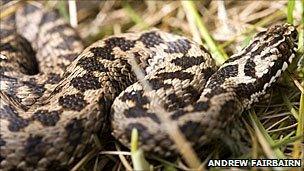Thousands of reptiles released in Wiltshire
- Published

Over 290 adders have been released at Blakehill Farm in Wiltshire
Thousands of reptiles from an Essex development site have been released at a former Wiltshire military base.
Over 24,000 reptiles living on the site where a container ship terminal is to be built have been moved to the county.
The "large-scale translocation" of adders, grass snakes, lizards and slow worms has been organised by the Swindon-based Environment Bank Limited.
"We would have preferred to have found a more local home for the reptiles," said the company's MD Robert Gillespie.
"But in this instance these sites in Wiltshire were the only ones we could identify with an environment that is almost perfect from day one."
The two Wiltshire receptor sites, both managed by the Wiltshire Wildlife Trust, include Sandpool Farm and the former military base of Blakehill Farm near Cricklade.
Sites checked
To "take on board the extra reptiles" a large additional area of land was purchased for the trust by the developers of the £1.5bn London Gateway port to meet the developer's obligations under EU law.
"The area of land links up four of the trust's neighbouring reserves including Clattinger Farm, Lower Moor Farm, Oaksey Meadow and Sandpool," said Magz Knight from the Wiltshire Wildlife Trust.
"Before any translocation is done the receptor sites are checked because obviously you don't want to bring a load of new reptiles in if there's already a population there that is the maximum amount you should have for that kind of habitat."
With both sites found to be suitable, over 290 adders, 400 grass snakes, 17,000 common lizards and 6,000 slow worms have been carefully captured by hand and transported in grass-lined boxes to the county.
Now "close to capacity", alternative receptor sites have been identified to house the "balance of the populations" still left at the London Gateway port site.
Reptile spotting
"We've got another three years of monitoring the reptiles in Wiltshire to go," said Mr Gillespie.
"But it's been a great success, they all seem to have settled in very well and are breeding."
With the release sites offering a combined area of 264 hectares, spotting an "Essex reptile" in Wiltshire may be unlikely.
"It is a place you could go because you know that reptiles are most definitely there and the habitat is set up for them to be there and stay there," said Ms. Knight.
"But I wouldn't like to guarantee that if you went there you would definitely see reptiles."